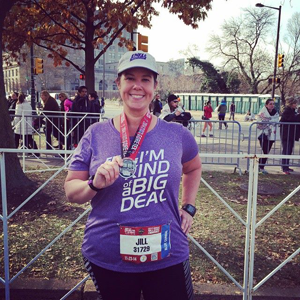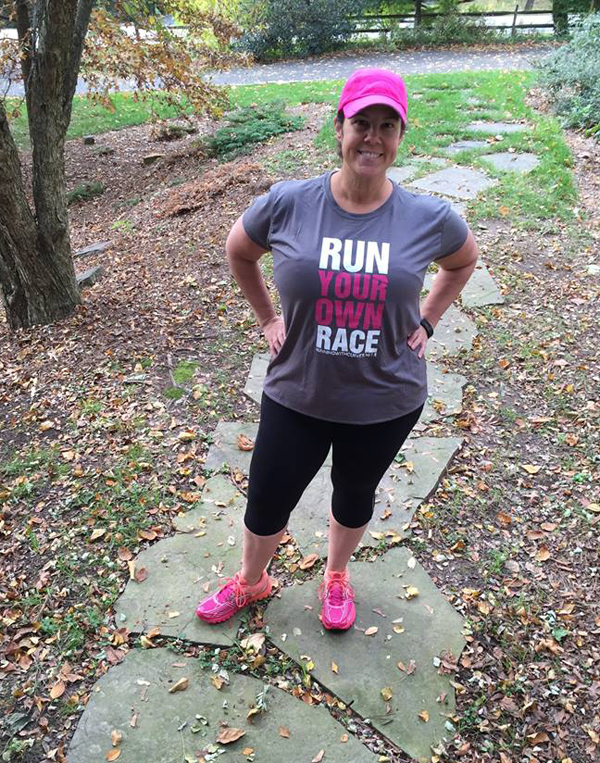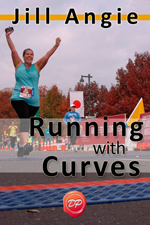Life does not play out in one linear path, it comes with ups and downs and lots of curves (pun intended) and hopefully along the way, we learn lessons that allow us to make changes to improve and enjoy our life even more. No one knows this more than Jill, our featured plus size athlete for January.

Photo courtesy of Jill, plus size athlete, who just finished completing the 2014 Philadelphia Half Marathon.
Since she started running in 1998, Jill has gone through some major transformations in her life, which have led to her changing careers, starting her own fitness blog (Running with Curves) and writing a running book.
This 47-year old runner, originally from Rochester, New York, now resides in Philadelphia, where she has a very pink personal training studio in her home, for training clients. When she’s not running 3-4 times a week training for a half marathon, her workouts are comprised of running 1-2 times a week mixed in with mini strength training sets. What’s playing on her iPod? Techno dance music, with a current obsession of Skrillex.
We talked with Jill to find out how she got started in running, how she overcame her fears and increased her confidence and the additional exercises need to improve your running form.
Jill
1. Who helped you get started with running? Are you self taught or did you get a coach or join a group?
I actually started running in 1998 as a way to lose weight. I trained by myself for a 5K, ran it and then stopped running again the next day. It took a few years of stops and starts before I finally became a regular runner in 2009. I took an e-course in 2011 which really helped, and last summer I ran with a local Galloway group. I also hired a personal trainer in 2009 which helped me build muscle strength to avoid injury - especially important for larger runners.
2. What were some of your concerns or fears with starting to run, and how did you overcome them?
When I first started, I was embarrassed to be seen in public running, so I wore the biggest, baggiest clothing I could find. I didn’t have access to a gym or a treadmill, and the only option was to run in my neighborhood. But I found that nobody was really looking at me and my confidence grew.
When I was finally able to join a gym, those same old fears popped up again - everyone is looking at me and judging me - but I just cranked up the music on my headphones and pretended I was completely alone and didn’t make eye contact with anyone. Eventually I realized nobody was looking at me at the gym, either - they were way too concerned with themselves.
Learning that lesson has really helped my confidence in all areas of my life. I’ve never had anyone comment on my size or speed while I was out running - and I don’t know if that’s because it’s never actually happened, or because I get so deeply into my own head that I literally don’t notice. Either way, I no longer spare a thought for what anyone else thinks when I’m running because I’m not out there to please anyone but myself.
3. How much does your nutrition factor into your athletic lifestyle and performance?
I am a sugar junkie. And when I eat too much of it, I notice an immediate impact on my running performance. My joints and muscles are stiff and achy, and I have very little energy. Lots of veggies, fruits and protein give me a huge performance boost both physically and mentally. I drink lots of water too.
That being said, I struggle just like everyone else with making good food choices, especially when my life gets crazy. Even though I ran consistently throughout the year, I gained almost 30 pounds in 2014, because there were some stressful events going on and I chose to deal with that stress by overeating foods that don’t fuel me properly.
I think the important thing is to remember that the goal is not perfection, but progress. As long as you get up one more time than you fall down, everything will be fine. And not to beat yourself up for gaining weight. Sure, being heavier makes running more difficult for me - but I am not defined by my body size or how fast I run. This is the size of my body right now, and it might be smaller or larger next month. But if I spend time thinking about how I will look and feel in the future, I miss out experiencing what’s going on right now.
Photo courtesy of Jill, sporting her own motto “run your own race.” Shirts available through her site Running with Curves.
I guess I got a little off track there! But I know that food and weight issues are a big concern for lots of people, and they can hold us back from reaching our potential - doing what we’re really meant to do in the world. It matters so much to me to help others understand that you don’t have to wait until you’re thin or your life is perfect to start living it.
4. Since you’re also a Personal Trainer, what exercise movements can you recommend to compliment and improve your running?
Lots of work to strengthen the butt, core, ankles and calves. Hamstring and quadricep strength is really important too - but running actually does a great job of strengthening those muscles. The butt is arguably the powerhouse of a runner’s stride and if it is weak (as is common in a lot of people), it can lead to injury.
Squats, lunges and calf raises are all great strength-training moves for runners. Avoid using the machines at the gym because they don’t allow your body to progress through its natural range of motion.
I also recommend gentle yoga for runners, because it’s a great way to loosen up muscles that tend to get really tight from running - especially the hip flexors.
5. What advice do you have for someone interested in getting started in running? (equipment, investment costs, time commitment,nutriton etc)
Running is a pretty inexpensive sport (although it’s easy to get crazy with all kinds of gadgets and gear). The only things you absolutely have to have are a good pair of running shoes and a good motion-control sports bra (I highly recommend the Enell Sport), and you’re all set to hit the road. Get a proper fitting for both.
Warm up for 5 minutes with a brisk walk, then do several short intervals of running interspersed with walking for a total of 30 minutes or so. A nice beginner ratio is 30 seconds run / 90 seconds walk. As it gets easier, you can increase the length of your running intervals and/or decrease the walking, and slowly increase your total time to 45 minutes.
Set your running pace by how you’re breathing. If you’re huffing and puffing so much that you can’t carry on a brief conversation, you’re going too fast. If you push yourself too hard in the beginning, you run the risk of getting injured, and then you won’t be running at all. Less is more when you’re a beginner.
6. Anything else you’d like to share for the readers?
Running is hard! If it doesn’t feel easy to you, don’t worry - there is nothing wrong. The more you do it, the easier it will get!
Thank you Jill for being open and honest about your journey to date. Being a Personal Trainer doesn’t make you immune to facing challenges, and as you said, getting up more times than you fall down is key to making progress.
To learn more about running for beginners, check out Jill’s book Running With Curves: Why You’re Not too Fat to Run, and the Skinny on How to Start Today.
To connect with Jill, you can find her at:
Website & blog: www.runningwithcurves.net
FB: facebook.com/runningwithcurves
IG: instagram.com/runningwithcurves



No comments yet.